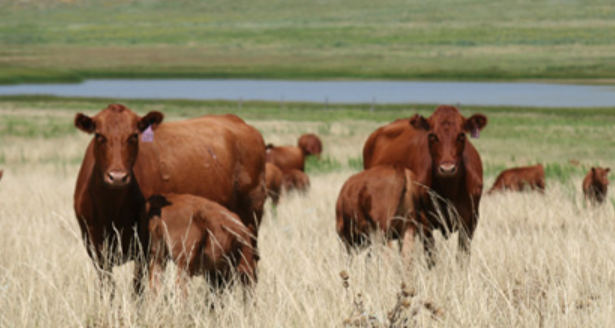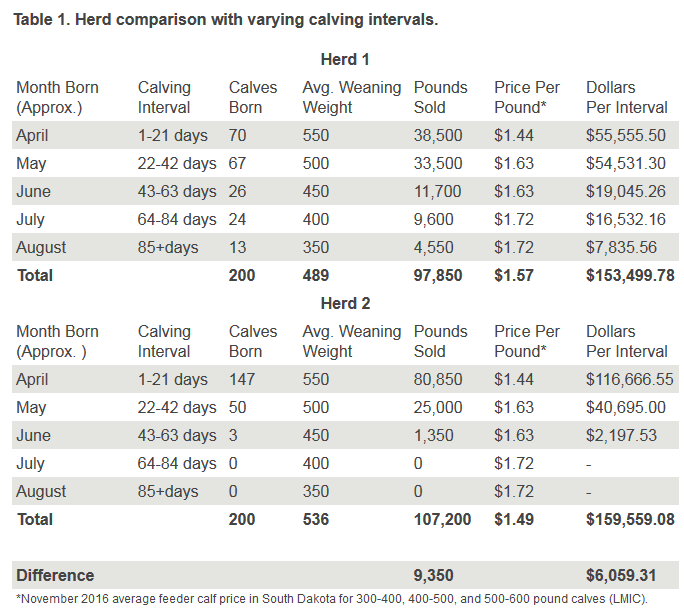 Heather Gessner, South Dakota State University Extension Livestock Business Management Field Specialist
Heather Gessner, South Dakota State University Extension Livestock Business Management Field Specialist
Standardized Performance Analysis
Pounds of beef sold is a key number for cattlemen. Late calvers, the cows that drag out the calving season, cost producers more than extra work and management, they are actually reducing herd income.
Standardized Performance Analysis (SPA) has been around for decades. This tool helps determine what the actual costs to raise a calf from breeding to weaning. Many producers create a budget for marketing and financing purposes, but SPA calculates the real, final costs. Use of both tools provide the opportunity for producers to evaluate the accuracy of the budget they created and also looks for problem areas in the operation.
Calving Intervals: Comparing Herds
One area of analysis provided by SPA is calving interval. Based on 21-day cycles, the calving interval determines the age of the calf at weaning and correlates to the size (pounds) of calf sold at weaning. For example, compare two herds, with varying calving intervals (Table 1).
Both herds begin calving April 1st, with 200 head calved, and there were no death losses reported.
- Herd 1 had an expected calving season with 13 cows, or 6.5%, of the herd calving more than 85 days after the first calf was born. The average weaning weight for herd 1 was 489 pounds, received an average of $1.57/pound, for a total return of $153,499.78.
- Herd 2 had a very tight calving season with 98.5 percent calving within the first 42 days of the season. The average weight was 536 pounds and had an average selling price of $1.49/pound for a return of $159,559.31.
Analysis
Based on similar situations Herd 2 even while receiving less on a per pound basis, returned $6,059 more than Herd 1, due to changing the average calving date and thus, the total weight sold.
 Considerations
Considerations
Labor at Calving
With a large percentage of the cows calving within a narrow time frame, cattlemen will be busy tending to cows, as there will be a larger number of calves born per day during this window. However, the labor requirements for calving season will be much narrower as the main need is 42 days in the Herd 2 example. After calving, time can be spent on other projects of the operation (ex. Crops planning, haying, etc.).
Bull Power
Bull power, either through artificial insemination (AI) or natural service needs to be considered. Both require additional costs for the operation. In order to narrow the calving interval a synchronization protocol will typically need to be utilized. This requires labor to move cows through the chute multiple times for the synchronization protocol and then again to AI the cows, as well as for heat detection if timed-breeding is not utilized.
If AI is not utilized, additional bulls may need to be raised or purchased to adequately cover the number of cows cycling at the same time. More bulls will result in additional feed costs and space to house them during the non-breeding season months.
Facilities
Calving a larger number of cows than before at one time may require the adaption of facilities to house the cows during their last weeks of gestation, as well as cow-calf pairs.
Calving Date
Cattlemen may also want to consider when they calve, if they plan to narrow their calving season. Changing from April 1st to May 1st calving may allow for cows to be calved on pasture, without as much weather or mud risk. This change should take into consideration other activities on the operation during May, and if everything can be appropriately managed following the change.
Sale Price
As noted in the two example herds, the price for calves varies by weight. Cattlemen should consider what the price difference is at their traditional sale barn. Also, the price difference between steers and heifers should be considered. In the example all calves were considered males.
Record Keeping
The first step to analyze your calving intervals is date, then knowing how many cows calved and when. These numbers can either be found in a calving book or using any other counting method (a calendar with tick marks indicating how many calved each day is fine.)
The Bottom Line
Calving interval may not seem like something you can manage, however, your herd may be giving up income potential that could be rectified in the 2018 breeding season. SDSU Extension has synchronization resources available to assist with changes in calving intervals and to assist with the Standardized Performance Analysis (SPA).
Additional Resources:
- Using Estrous Synchronization in Natural-Service Breeding Situations
- Using the Estrus Synchronization Planner
- Synchronization Protocols
- Jump Starting Those Late Calving Cows
- Minimizing Stress to Enhance Embryo Retention
- Northwest Florida Beef Cattle Conference & Trade Show – February 11 - December 19, 2025
- Friday Feature:The Sears Catalog –How Rural America Shopped before the Internet - December 19, 2025
- November 2025 Weather Summary & Winter Outlook - December 5, 2025
